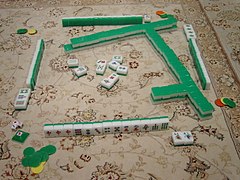Mah Jong
Mahjong
 |
| Players |
2-4 |
| Age range |
4 years and older |
| Setup time |
1-5 minutes |
| Playing time |
Dependent on variation and/or house/tournament rules |
| Random chance |
Yes |
| Skill(s) required |
Tactics, observation, memory, teamwork |
Mahjong ( listen ), also spelled majiang and numerous other variants, is a tile-based game that originated in China during the Qing dynasty. It is commonly played by four players (with some three-player variations found in South Korea and Japan). The game and its regional variants are widely played throughout Eastern and South Eastern Asia and have a small following in Western countries. Similar to the Western card game rummy, Mahjong is a game of skill, strategy, and calculation and involves a degree of chance.
listen ), also spelled majiang and numerous other variants, is a tile-based game that originated in China during the Qing dynasty. It is commonly played by four players (with some three-player variations found in South Korea and Japan). The game and its regional variants are widely played throughout Eastern and South Eastern Asia and have a small following in Western countries. Similar to the Western card game rummy, Mahjong is a game of skill, strategy, and calculation and involves a degree of chance.
The game is played with a set of 144 tiles based on Chinese characters and symbols, although some regional variations may omit some tiles and/or add unique tiles. In most variations, each player begins by receiving 13 tiles. In turn players draw and discard tiles until they complete a legal hand using the 14th drawn tile to form 4 groups (meld) and a pair (eye). There are fairly standard rules about how a piece is drawn, how a piece is robbed from another player, the use of simples (numbered tiles) and honors (winds and dragons), the kinds of melds allowed, how to deal the tiles and the order of play. Despite these similarities, there are many regional variations to the rules including rather different scoring systems, criteria for legal winning hands and even private table rules which distinguish some variations as notably different styles of mahjong.
In Chinese, the game was originally called 麻雀 (pinyin: máquè)—meaning sparrow—which is still the name most commonly used in some southern Chinese varieties such as Cantonese and Min Nan (Hokkien and its relatives), as well as in Korean and Japanese. However, most Mandarin-speaking Chinese now call the game májiàng (麻將). In the Taihu dialects of Wu (Shanghainese and its relatives), it is pronounced as 麻將 ([mo tsiaŋ]), but in actuality, 麻將 is the diminutive form of 麻雀, written as 麻雀兒 ([mo tsiaʔ ŋ]), due to an erhua event. It is through the Wu Chinese pronunciation of 麻雀兒 that the diminutive form of 麻雀 in Taihu Wu became known as 麻將 in both Wu and Mandarin.
...
Wikipedia

![]() listen ), also spelled majiang and numerous other variants, is a tile-based game that originated in China during the Qing dynasty. It is commonly played by four players (with some three-player variations found in South Korea and Japan). The game and its regional variants are widely played throughout Eastern and South Eastern Asia and have a small following in Western countries. Similar to the Western card game rummy, Mahjong is a game of skill, strategy, and calculation and involves a degree of chance.
listen ), also spelled majiang and numerous other variants, is a tile-based game that originated in China during the Qing dynasty. It is commonly played by four players (with some three-player variations found in South Korea and Japan). The game and its regional variants are widely played throughout Eastern and South Eastern Asia and have a small following in Western countries. Similar to the Western card game rummy, Mahjong is a game of skill, strategy, and calculation and involves a degree of chance.
